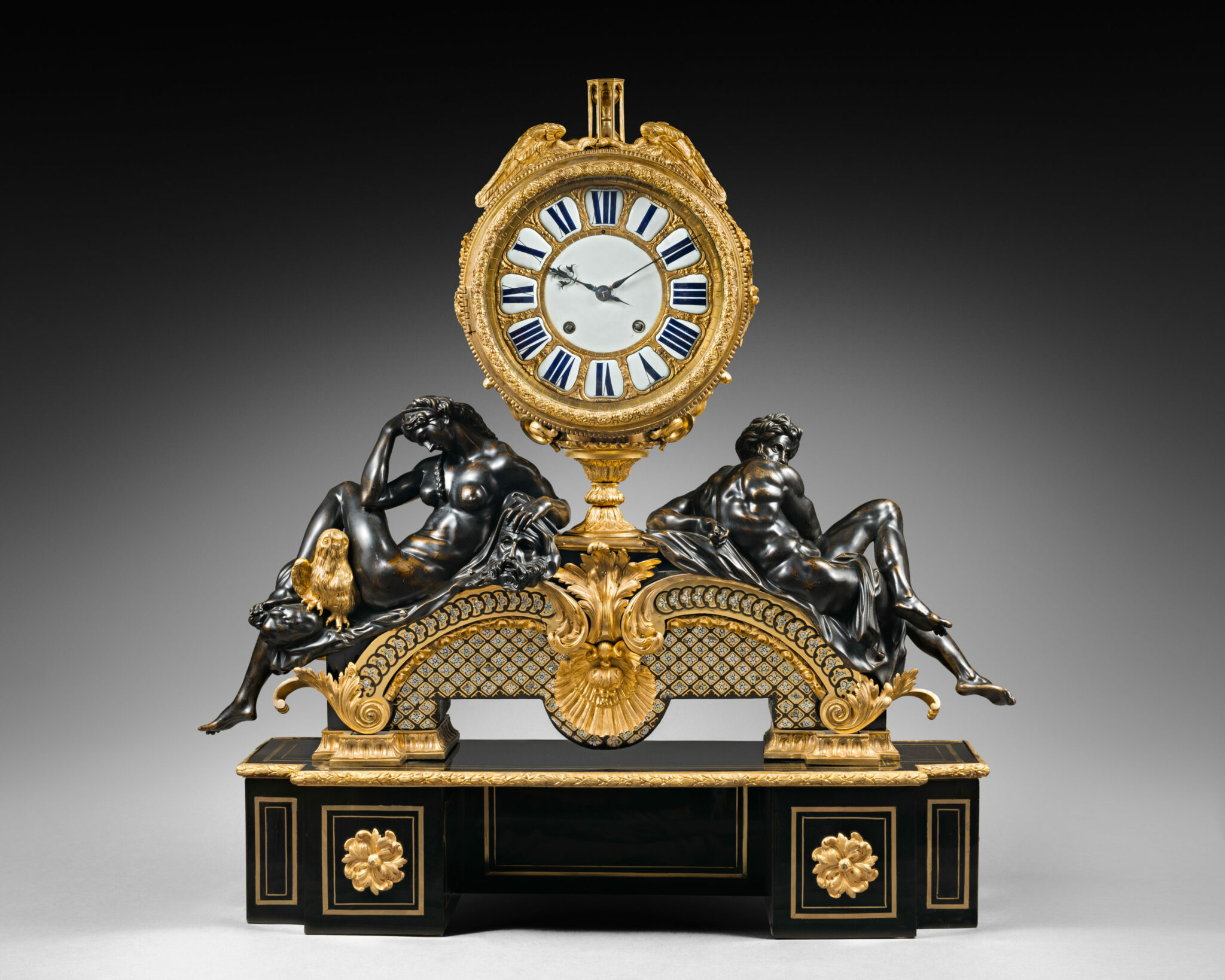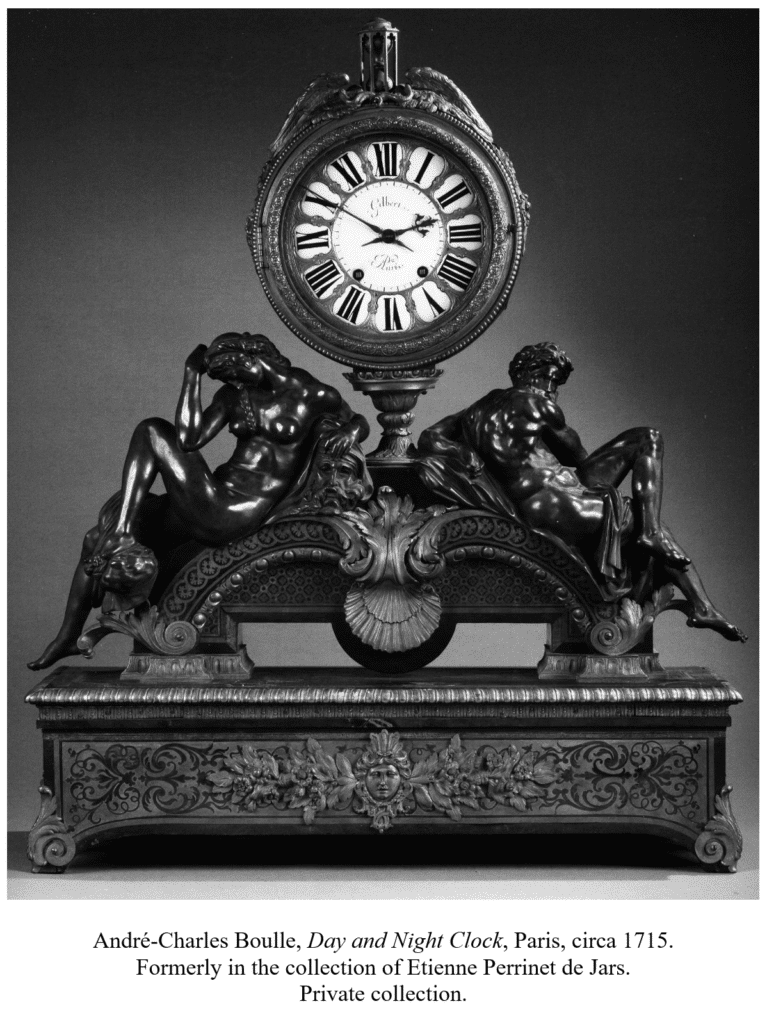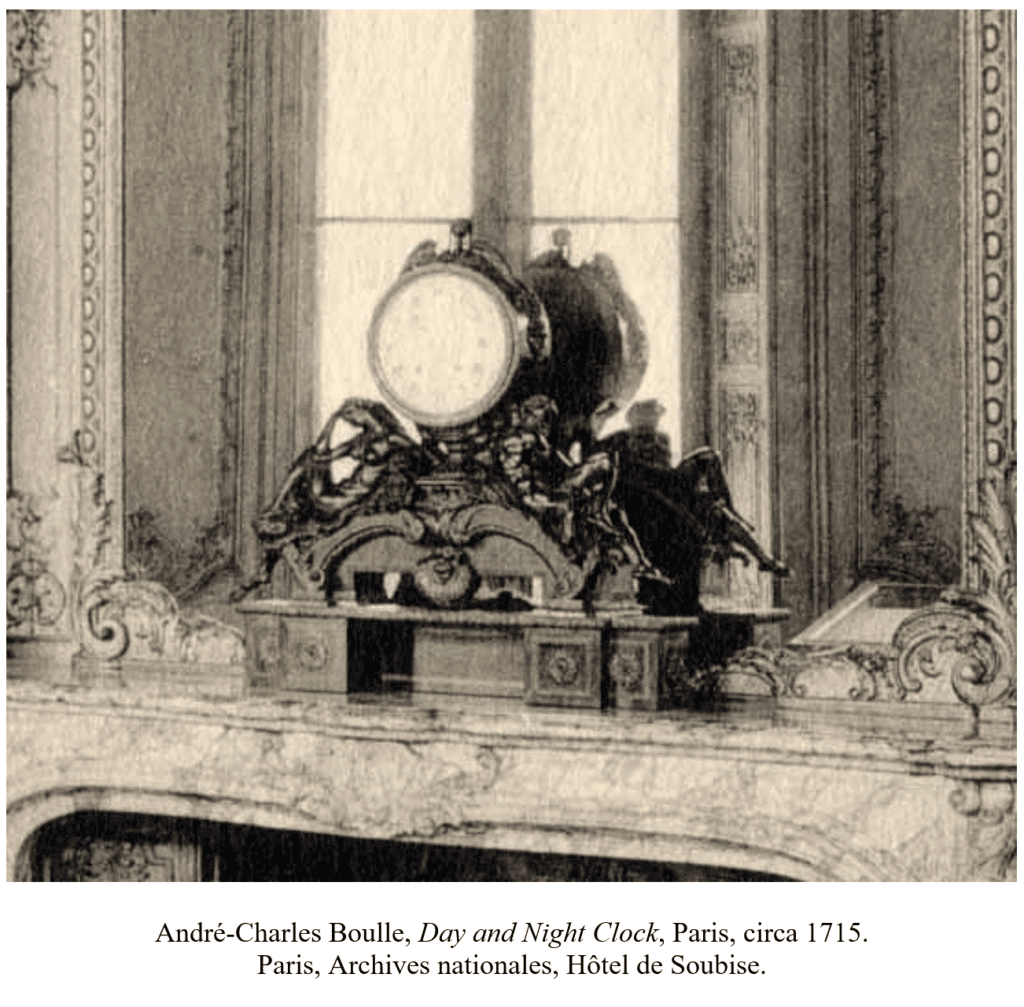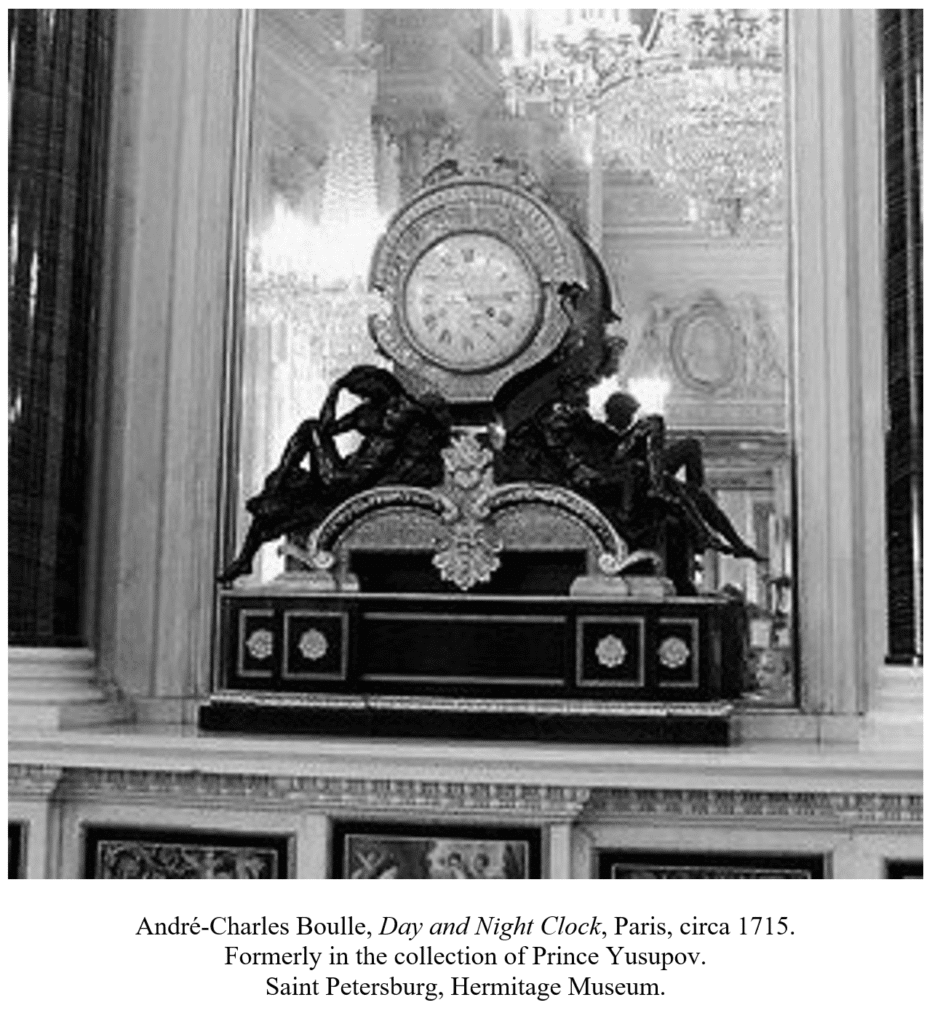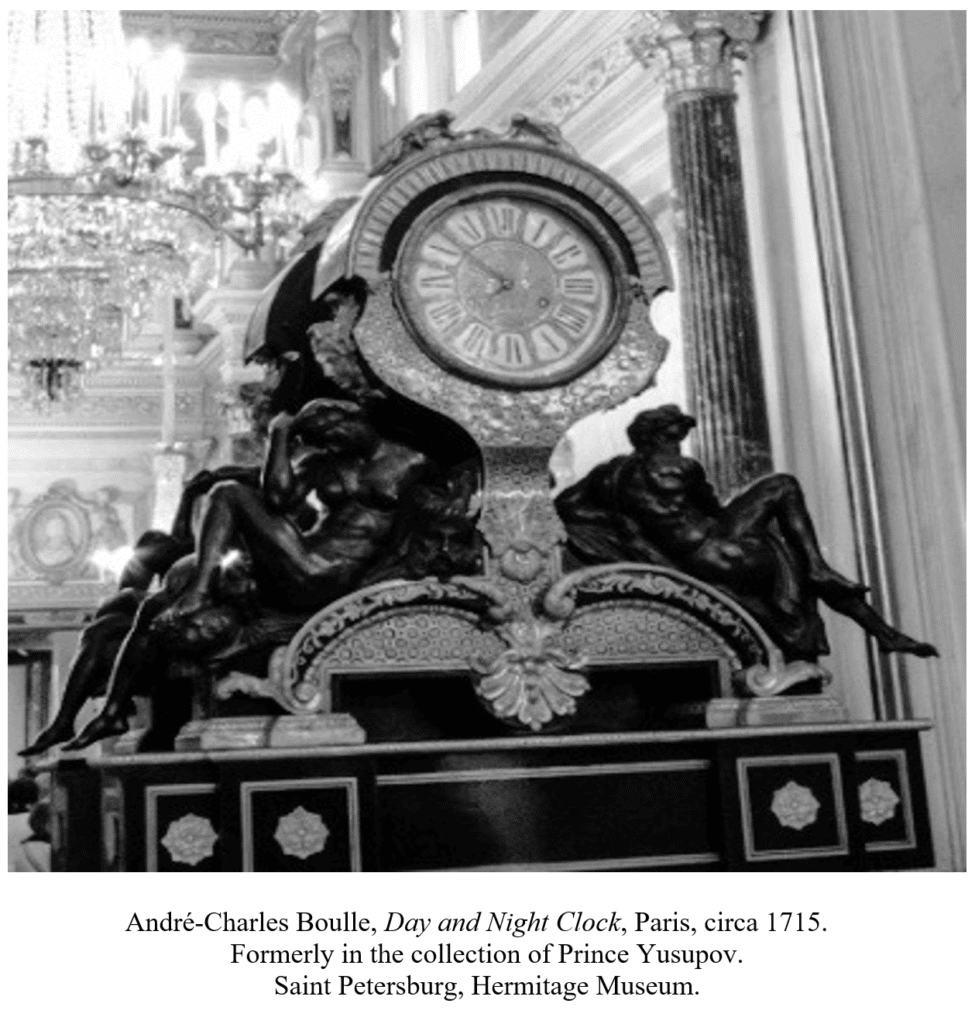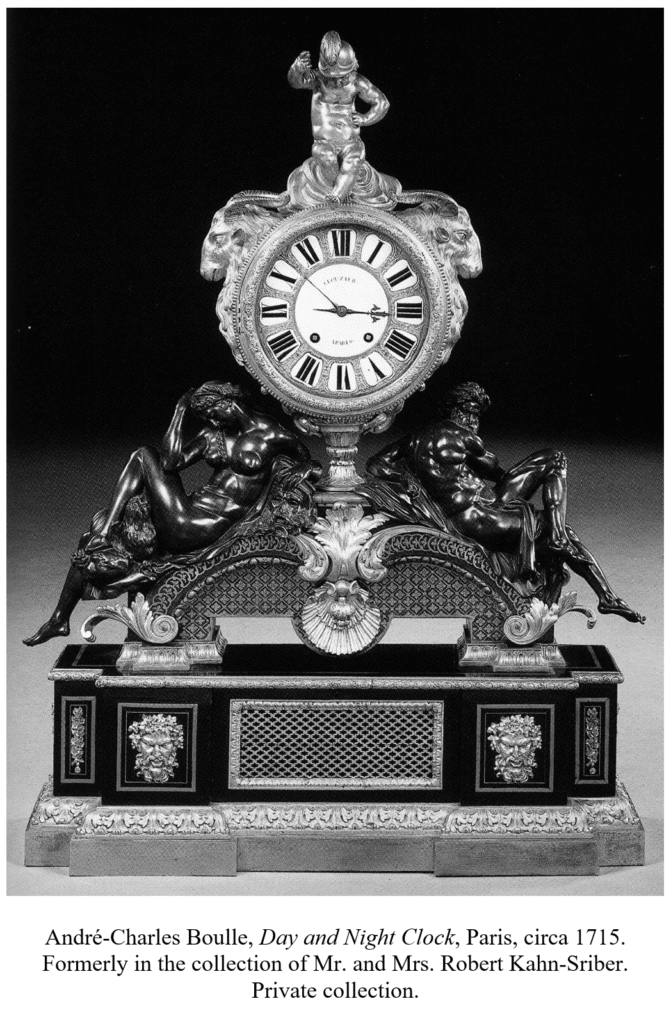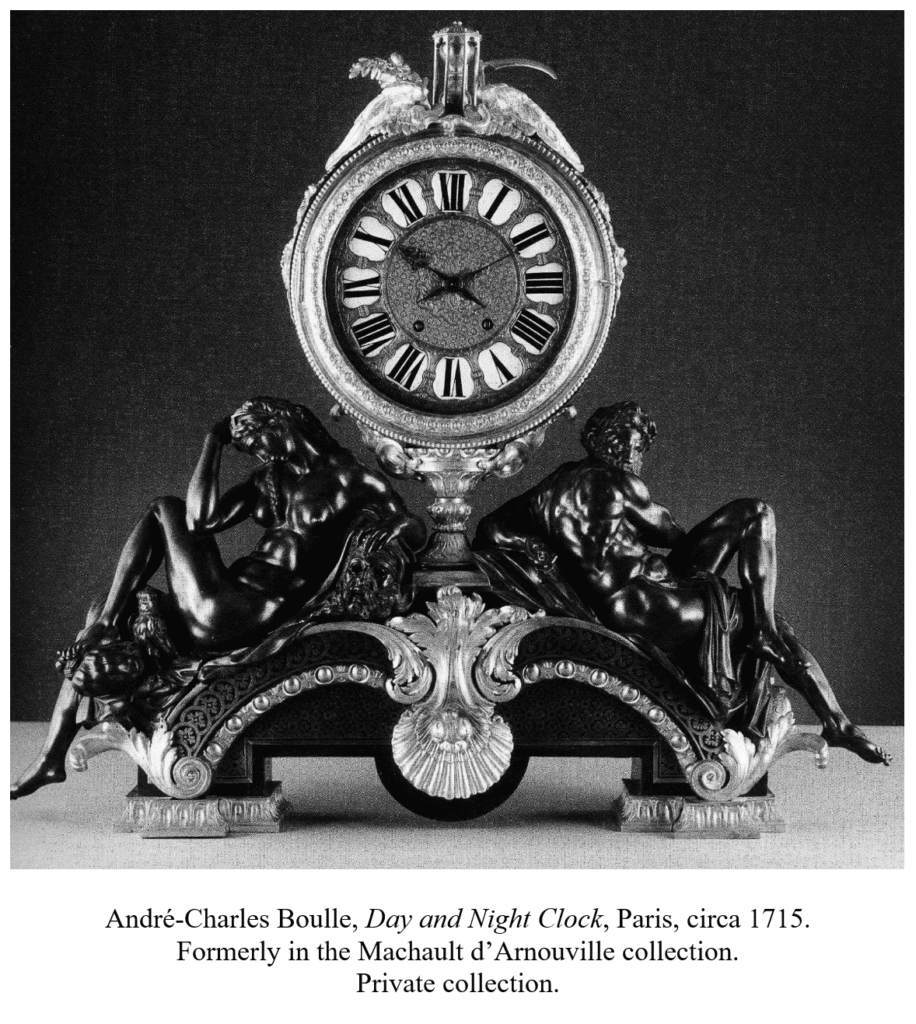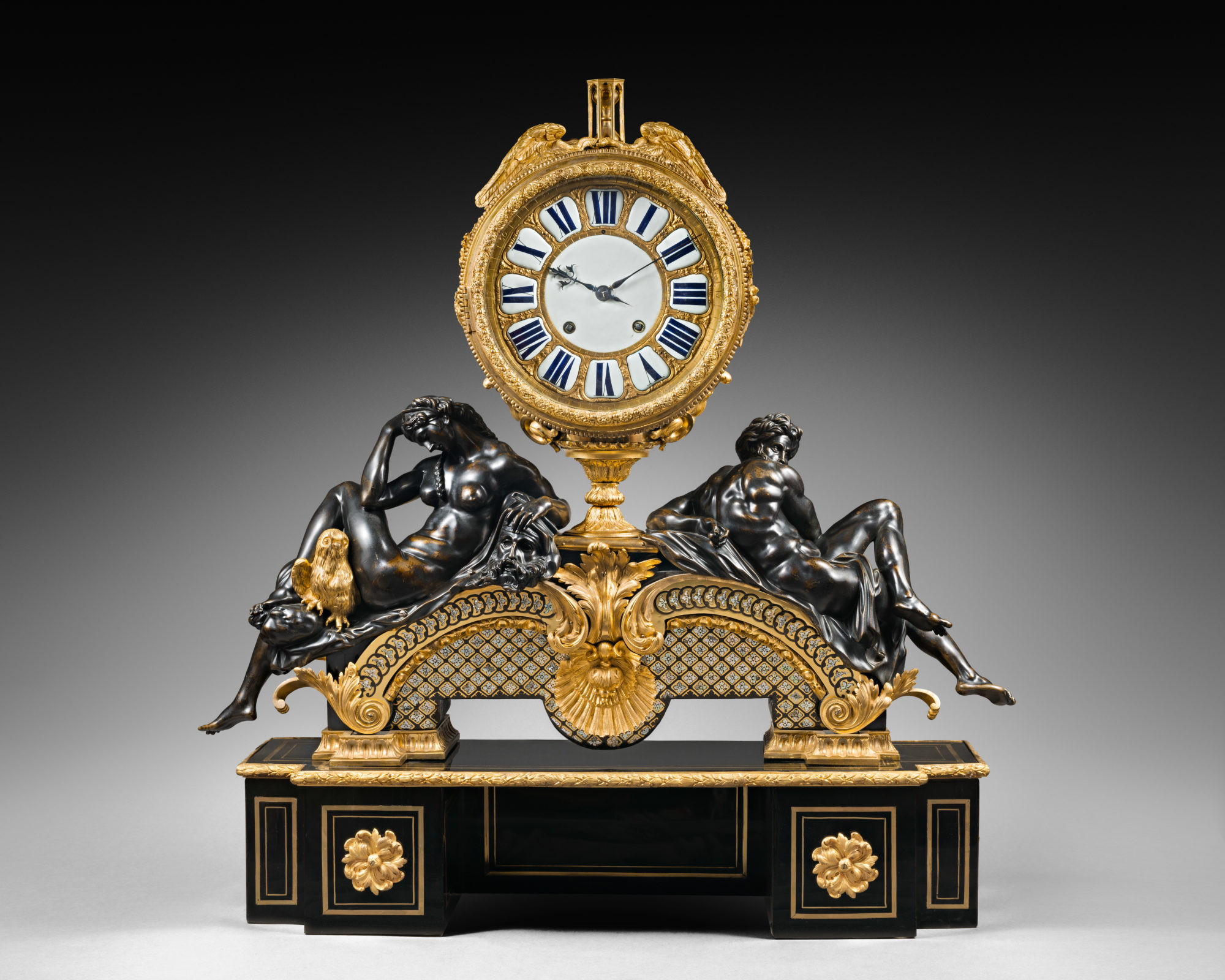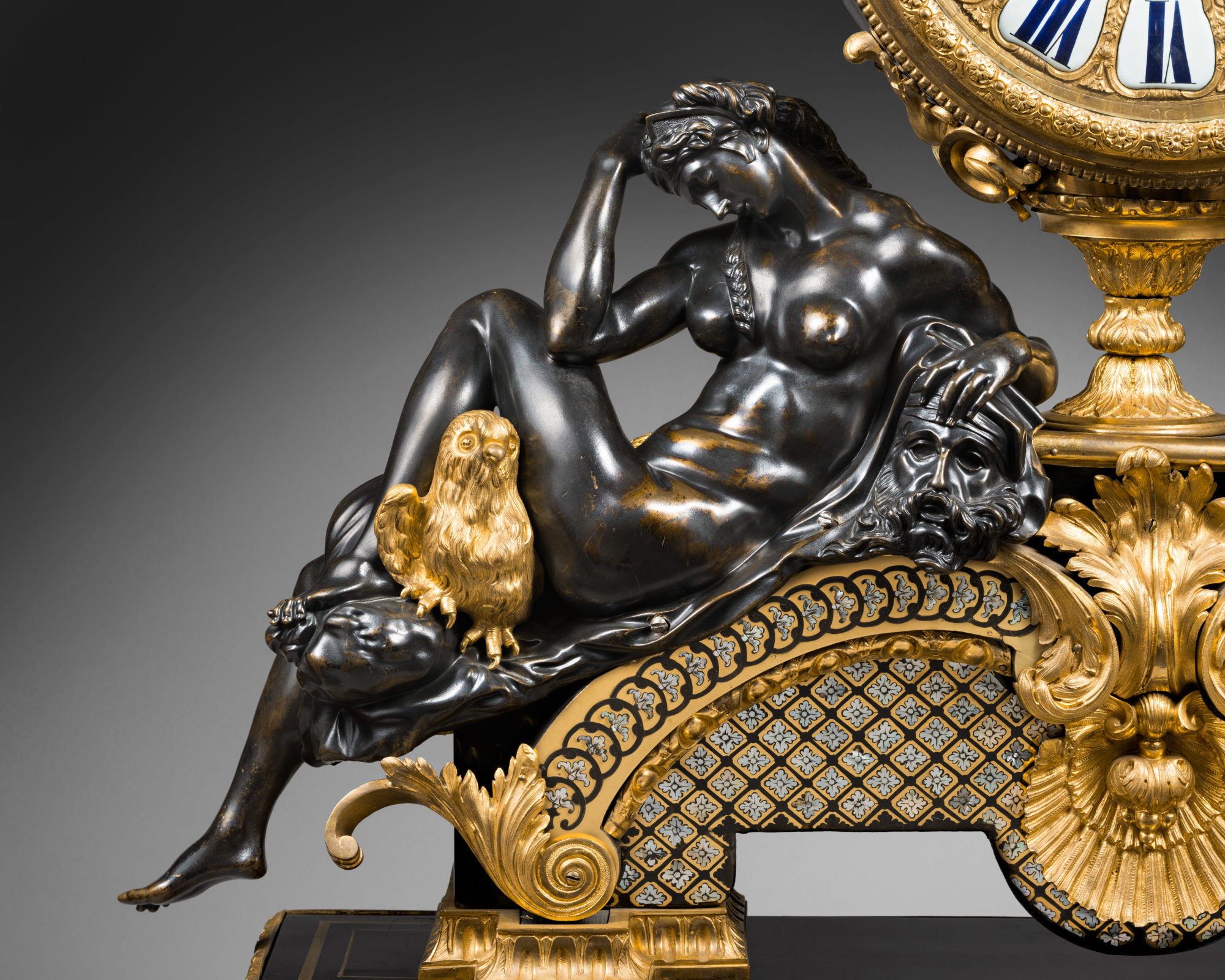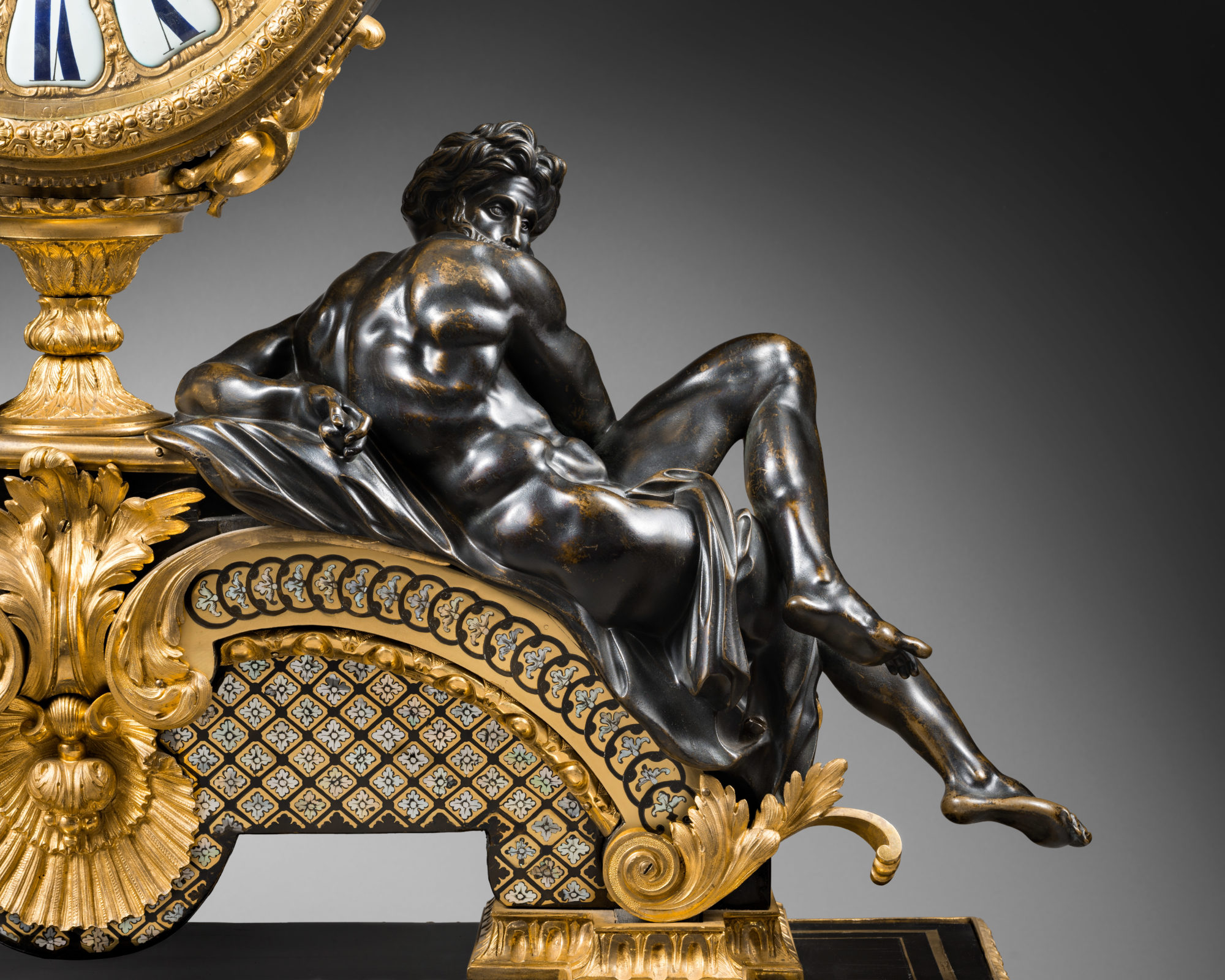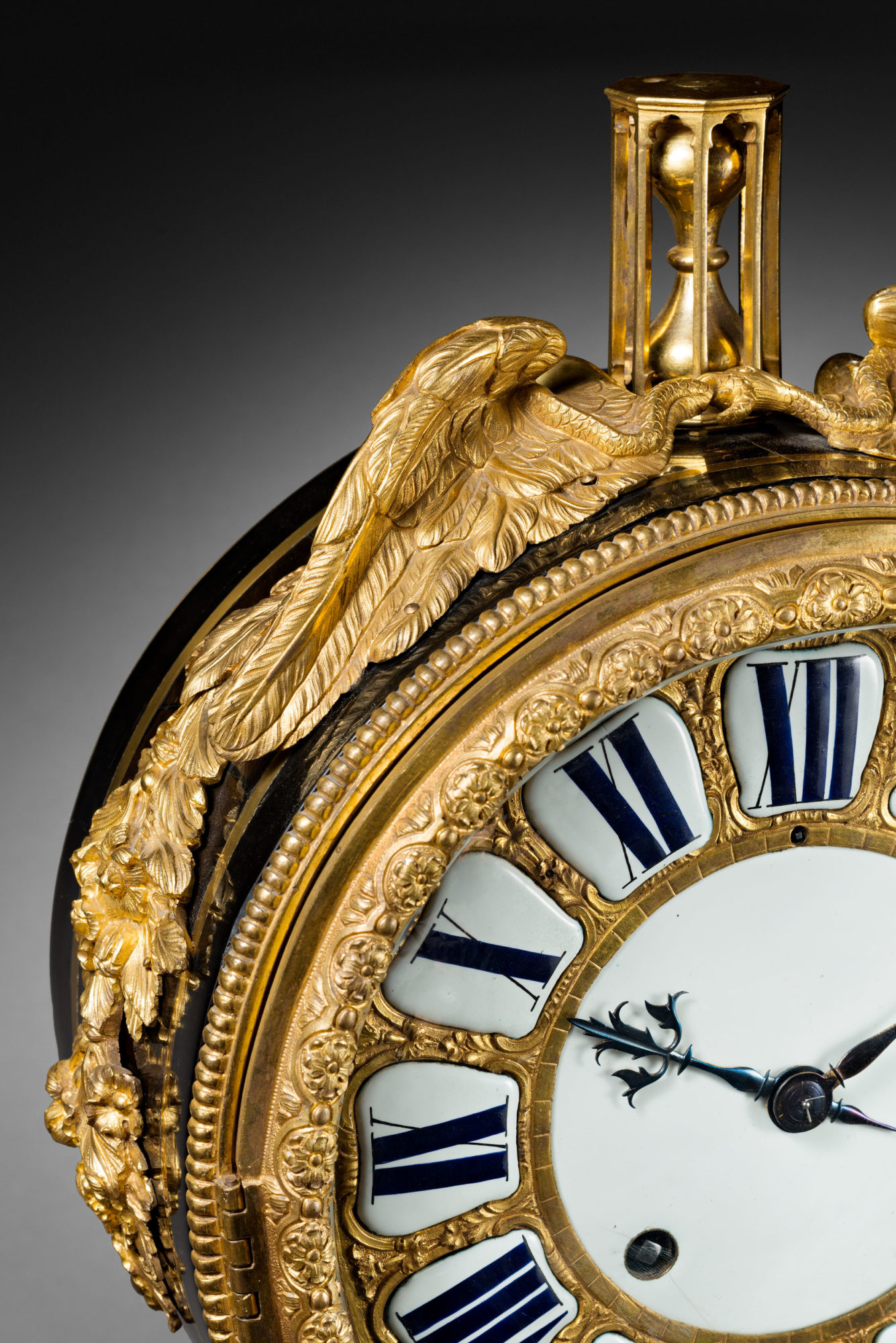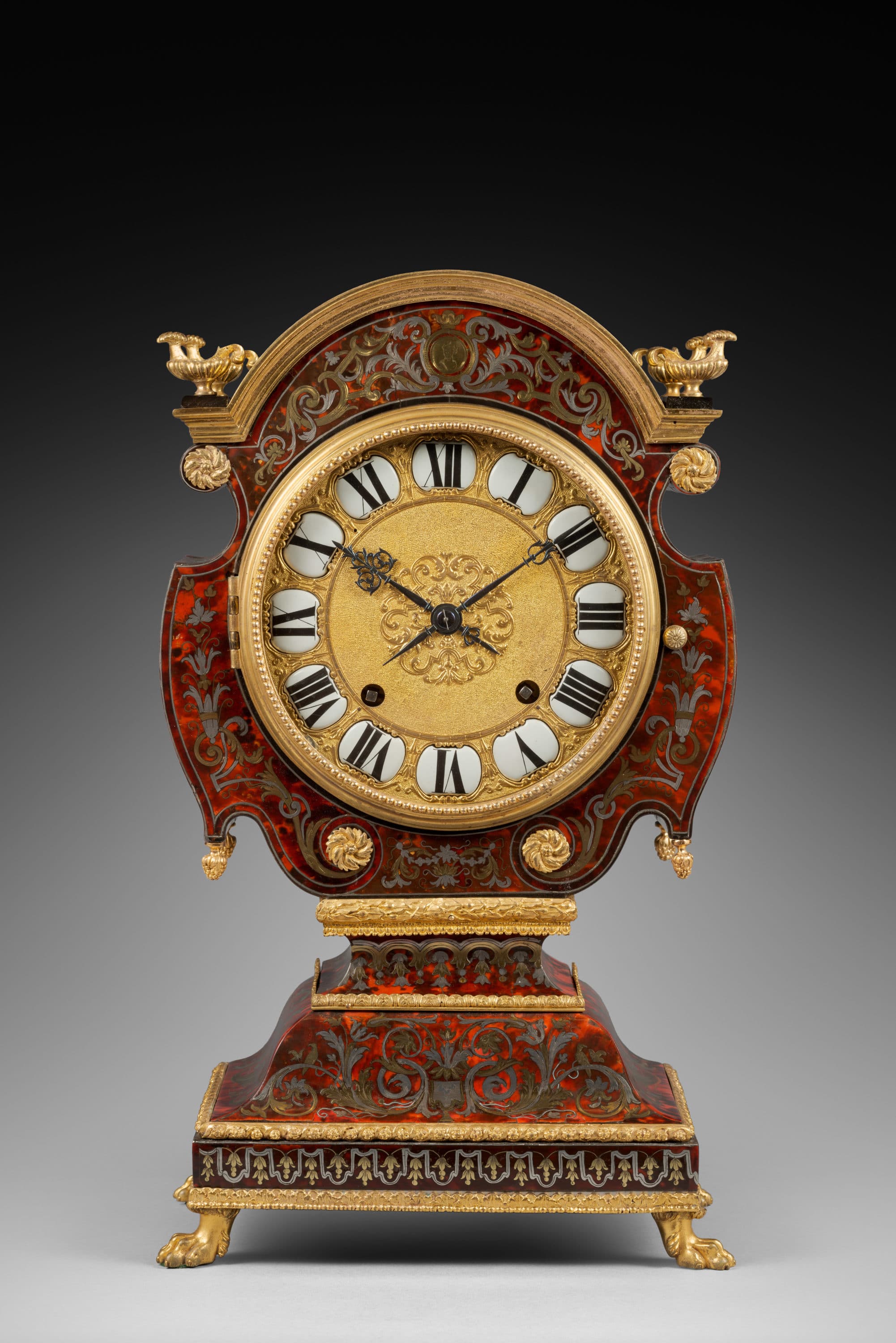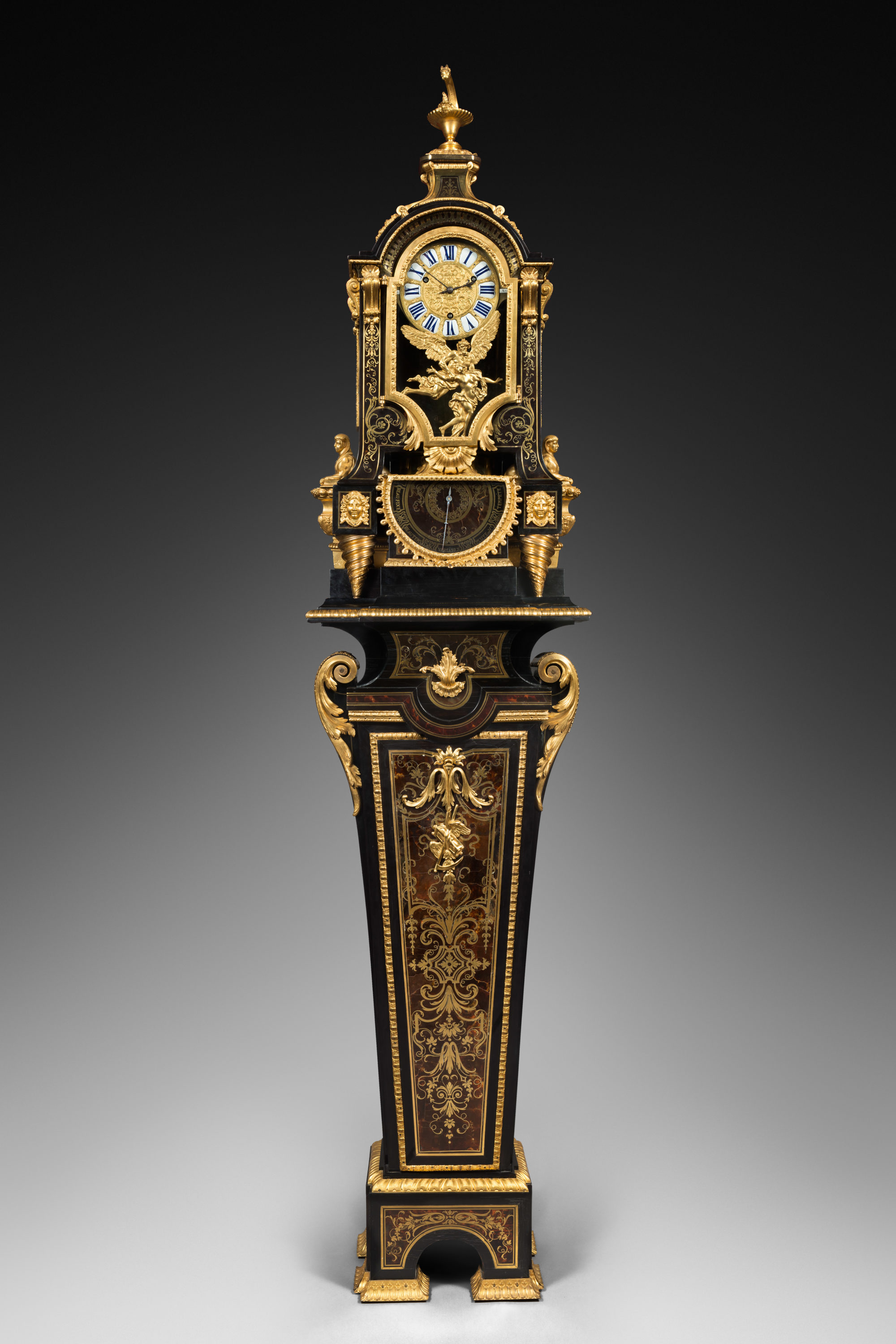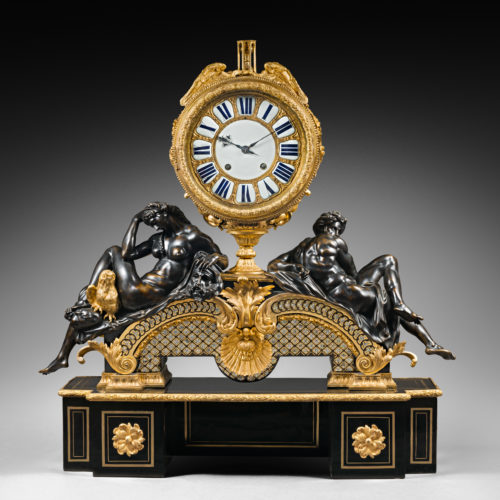Exceptional Ebony Veneered, Gilt and Patinated Bronze, and Copper, Tortoiseshell and Mother of Pearl Boulle Marquetry Clock
“Day and Night”
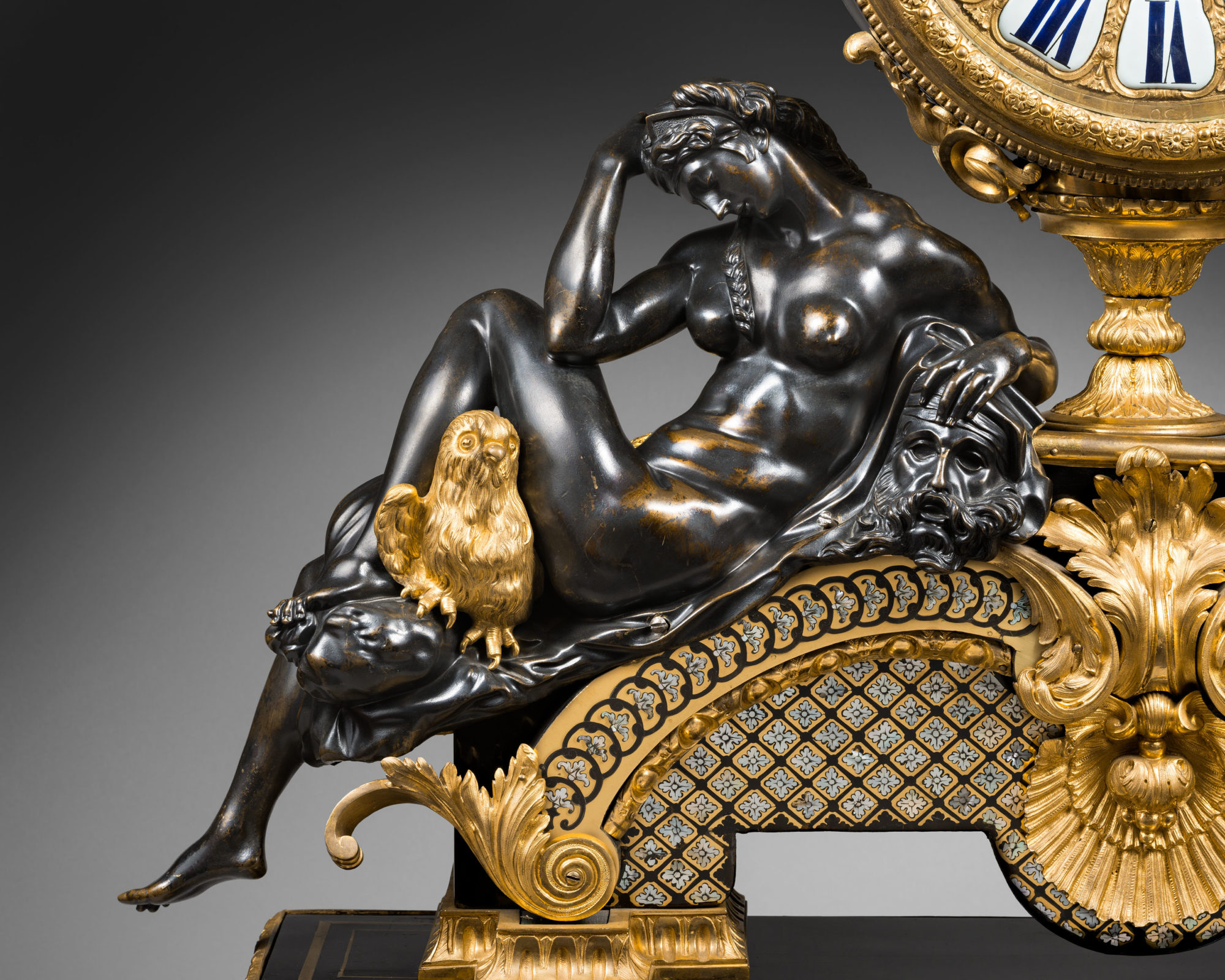
Paris, late Louis XIV period, circa 1715
Case Attributed to André-Charles Boulle
Signed “Etienne Le Noir A Paris” on the rear plate of the movement
Provenance:
– Possibly from the collection of Antoine-Jean-Baptiste Dutartre (circa 1720-1803), equerry, Parisian solicitor and Paymaster General of the Bâtiments du Roi.
The round brass dial has thirteen enameled cartouches; it indicates the Roman numeral hours and the outermost minutes graduations by means of two blued steel hands. The movement, whose back plate is signed “Etienne Le Noir à Paris”, is housed in a round ebony-veneered case adorned with brass bands and flower swags. The bezel, with alternating rosettes and egg and dart friezes, is further adorned with bead friezes, and is surmounted by an hourglass flanked by the wings of Time, and stands on a pedestal adorned with a knop and has a leaf-decorated pedestal. The whole is set on an architectural entablature on which recline two magnificent patinated figures based on the marble figures Michelangelo created to decorate the tomb of Julien de Medici in Florence. One is a woman lying on a drapery that is adorned with a mask and a gilt bronze owl, who symbolizes Night. The other figure, an allegory of the Day, depicts a man who is turning toward the viewer. The two figures are set on an arch in the form of leaf-decorated scrolls that terminate in volutes, curved bands with egg and dart friezes, flowerets and acanthus-adorned C scrolls, stylized shells with seeds and bases with friezes of fluting and waterleaves against a matted ground. These finely chased gilt bronze motifs are set against a tortoiseshell ground with flower-decorated piasters and latticework centered by mother of pearl four-leaf clovers set against a copper ground. The shaped, ebony-veneered quadrangular base is adorned with brass-framed reserves and a torus of laurel leaves and seeds that is decorated with spiral rosettes.
Discover our entire collection of antique mantel clocks for sale and luxury antique clocks online or at the gallery.
The remarkable design of the present exceptional clock may be confidently attributed to André-Charles Boulle (1642-1732), one of the most emblematic artistic figures of the reign of Louis XIV and the Regency period. A cabinetmaker, sculptor, chaser and gilder, with a vast body of work, the extant examples of which are of exceptional quality. In addition to his “ordinary” creations, mostly commodes, desks, armoires, and bookshelves, he created clocks and regulators which are often spectacular in design, and which demonstrate his marquetry skills and his inventiveness. Boulle created a remarkable body of work that included bronze furnishings – mostly wall lights and firedogs – as well as other horological creations such as cartels, mantel clocks, and regulators, which make up an important portion of his work, since they comprise approximately one third of his body of work. A 1715 document (an acte de délaissement that Boulle drew up in favor of his sons) 63 clocks were mentioned, out of a total of 300 pieces valued. Several years later, in August 1720, when the inventory of the workshop was drawn up after a fire, 75 clocks were listed out of a total of 220 pieces. Boulle’s work was consistently creative. He sourced his movements from the most important clockmakers of the period.
Several documents from the period concern the workshop of André-Charles Boulle, and either mention the two allegories of Day and Night that adorn the present clock, or contain drawings of them. The 1715 acte de délaissement des biens in which André-Charles Boulle donated property to his sons contains a reference to “The models of the figures by Michelangelo repaired in bronze and two others that have just been cast”. In 1732, in Boulle’s probate inventory, were described: “n°90 The models of the clock with the figures of Michelangelo weighing sixty-eight livres, valued at one hundred sols the livre – 340 livres” (see J-P. Samoyault, André-Charles Boulle et sa famille, nouvelles recherches, nouveaux documents, Geneva, 1979). These allegories also appear in the upper portions of pieces, in two preparatory drawings attributed to Boulle. The first, whose whereabouts are not known today, was formerly in the Staatliche Schlösser und Gärten collection in Berlin (see H. Ottomeyer and P. Pröschel, Vergoldete Bronzen, Band II, Munich, 1986, p. 481, fig. 10). The second is in the Hermitage Museum in Saint Petersburg (illustrated in the exhibition catalogue “André-Charles Boulle 1642-1732, Un nouveau style pour l’Europe”, Museum für Angewandte Kunst, Frankfurt, 2009, p. 312-313, n° 55).
Immediately after its creation, toward the end of the reign of Louis XIV, this spectacular clock model, perfectly balanced and elegant, became immensely successful among important Parisian collectors. In 1719, Boulle delivered to Louis-Charles de Machault d’Arnouville a bureau plat with a cartonnier that was surmounted by a clock with the figures of the Day and the Night. The following year, the Duke of Bourbon ordered a clock of the same model, whose dial was signed “Mesnil”; the clock remained in the collections of the princes of Condé throughout the 18th century and was confiscated during the Revolution. In 1723, the marchand-mercier Thomas-Joachim Hébert ordered a further example that was later sold, probably to Monsieur d’Argenson. A fourth example, whose dial was signed “Baillon”, was mentioned as being in the collection of the Duke of Orléans at the château du Raincy.
The other known descriptions of this clock model, in auction catalogues and the probate inventories of important 18th century collectors offer additional information.
One such clock was described in the probate inventory of Fermier Général Etienne Perrinet de Jars in July 1762. In the Grand Cabinet of his mansion in the rue du Faubourg Saint-Honoré there was : “ …a bureau six feet long, with Boulle marquetry, and three two-sided drawers, its corners, casings, escutcheons, façades and carderons are of gilt brass and it is further endowed with a matching serre-papier that supports a base that is also in Boulle marquetry, which is surmounted by two bronze figures and an œil de bœuf clock in its en-suite decorated case garnished with gilt bronze, with an enamel dial that indicates the hours and bears the name of Gilbert in Paris 1400 livres”.
A second example was featured in March 1767 in the sale of the collection of the renowned connoisseur Jean de Julienne: “1632. A superb Boulle marquetry clock, garnished with gilt bronze ornaments, the movement by Baillon, the design is remarkable and perfectly composed, its sides feature two reclining bronze figures, depicting the Day and the Night, for which Boulle took his inspiration from those created by Michelangelo for the tomb of Lorenzo de Medici in the San Lorenzo chapel in Rome; this clock is 33 pouces 6 lignes long by 35 pouces 6 lignes high. Two large square gilt bronze bases measuring 6 pouces 6 lignes serving as a platform”; sold for 1421 livres.
A third was described in the sale catalogue of the collection of the Count de Lauraguais le 12 mars 1772: “23. A beautiful clock of unusual design, in Boulle marquetry, its sides are adorned with 2 bronze figures that represent the Day and Night, after Michelangelo. The movement is by Brourie”.
A fourth example appeared in the catalogue of the sale of the Randon de Boisset collection in February 1777: “A clock, with quarter striking movement, bearing the name C.D.G. Mesnil in its case with an elaborate dial featuring bas-reliefs of children, surmounted by an hourglass, with further attributes of Time, on a gilt bronze stem, accompanied on the sides by two bronze figures, seated and leaning, representing the Day and Night, placed on a pedestal base, with recessed panel adorned with marquetry, garnished with flowers, egg and dart molding, the front portion of the base on either side in gilt bronze, and supported by another ebony veneered pedestal in with bands of plain copper, with an entablature adorned with molding and rosettes, supported by six cubes with gilt bronze rosettes; the whole placed on a base sculpted and gilt wood: height 37 pouces, by 32 long and 8 deep. This clock, by Boulle, is important due to the strong impression created by its design and the extraordinary perfection of the figures and ornaments. The artist took his inspiration for the figures from Michelangelo: it came from the cabinet of M. de Julienne (this provenance is erroneous)”; it was sold for 1901 livres in Beauvarlet, then appeared in the latter’s sale on 13 March 1798: “168. A case forming the lower portion of an armoire, on which is placed a serre-papier; contre-partie featuring mascarons, bands and other ornaments in gilt bronze, surmounted by a clock with movement by Mesnil in Paris, striking the hours, half hours, and quarter hours; it is accompanied by two allegorical figures in patinated bronze and is terminated by an hourglass: the shaped base is garnished with bronze ornaments. Total height 4 pieds 9 pouces, width 2 pieds 9 pouces, depth 1 pied 9 pouces 9 lignes”.
A fifth example was described in an anonymous sale that was in fact the sale of the collection of the Duke de la Vrillière in June 1777: “56. A desk, tambour, serre-papier, with clock, Boulle marquetry. Said clock in marquetry mosaic, adorned with 2 reclining figures in bronze, the other ornaments in ormolu gilt bronze. The bureau and accessories in première partie marquetry, adorned with espagnolette-head swags, scrolls, mascarons, molding, legs and carderons, the whole in ormolu gilt bronze”.
A sixth example, probably of the same model, was described in an anonymous sale in December 1780: “A Boulle marquetry desk, with a blue ground, 6 pieds in length, with a serre-papier, garnished with de 6 cases serving as drawers, covered in blue morocco leather with gold trimming, and chased gilt ormolu copper knobs, and a clock with two reclining bronze figures, the whole garnished with ornaments of chased gilt ormolu copper”.
A seventh example, perhaps the present model, was offered at auction when the collection of Antoine-Jean-Baptiste Dutartre was sold in March 1804: “68. Large and richly adorned bureau in seconde partie Boulle marquetry, elaborately decorated with copper molding, swags, mascarons and rosettes, with fine ormolu gilding, with its box and serre-papier surmounted by an excellent clock bearing the name of Lenoir in Paris. This exceptional article will be accompanied by a similarly decorated writing case and stand. Length of the bureau 67 pouces”.
One further example, the eighth, was in the collection of President de Nicolay. Confiscated during the Revolution, it was restituted to his heirs: “A bureau with four console feet with figures and lions’ claws, frame and mascaron opening with three drawers with knobs featuring ormolu gilt bronze carderons with marquetry panels with a copper ground and tortoiseshell, 6 feet long and three feet wide, the serre-papier in marquetry adorned with gilt bronze, surmounted by a clock in marquetry, mascaron and other bronze ornaments, reclining figure, all by Boulle 3600 livres”. (Archives nationales, O/2/486); it was sold several months later: “A very fine bureau six feet long, with two-part serre-papier, surmounted by a clock adorned with male and female figures, after Michelangelo, with antique patina; the rest of the bureau in marquetry garnished with ormolu gilt bronze”.
It should be remembered that the above-mentioned clocks, which were mentioned or described with varying degrees of precision during the 18th century, sometimes without the name of the clockmaker, often went from collection to collection. Thus it is difficult to estimate the total number of examples that were produced in the workshop of André-Charles Boulle (probably approximately ten). Today, only eight “Day and Night” clocks are known:
– One example, whose dial is signed “Pierre Leroy”, formerly in an important private collection in Belgium, was sold by Christie’s, Monaco, on 13 December 1998, lot 400.
– A second example, whose dial was signed “Gilbert à Paris”, is the one mentioned in the 1762 probate inventory of Etienne Perrinet de Jars; it remained the property of his descendents throughout the 19th century. It appeared on the Paris art market in 2008 (sold in Paris, Hôtel Drouot, on June 18, 2008, lot 45), it is today in a private collection.
– A third one, whose dial was signed “Lepaute à Paris”, was delivered to the prince de Bourbon in 1720. Its original movement by Claude I Dugrand-Mesnil was replaced circa 1780 by Jean-Baptiste Lepaute. Today that clock stands in one of the rooms of the Hôtel de Soubise in the Paris Archives nationales (Musée de l’Histoire de France, illustrated in J-D. Augarde, Les ouvriers du Temps, La pendule à Paris de Louis XIV à Napoléon Ier, Geneva, 1996, p. 197, fig. 158; H. Ottomeyer and P. Pröschel, Vergoldete Bronzen, Die Bronzearbeiten des Spätbarock und Klassizismus, Band I, Munich, 1986, p. 45, fig. 1.4.4).
– Two clocks, one whose dial is signed “Masson”, and the other “Lepaute”, are in the Hermitage Museum in Saint Petersburg. Both were in the collection of Prince Yusupov.
– A sixth clock, whose dial is signed “Clouzier à Paris”, features variations in the treatment of its decoration. It was formerly in the collection of Mr and Mme Robert Kahn-Sriber and stood in their avenue Foch apartment; it was offered on the New York art market in 2004 at the sale of the Greenberg collection (sold Sotheby’s, 21 May 2004, lot 31).
– A seventh clock was ordered in 1719 by Louis-Charles de Machault d’Arnouville. It remained in the family and in July 1877 its value was estimated at 30,000 francs in the probate inventory of Marquis Léonce de Vogüé: “A clock by Boulle, figures of Michelangelo”. Acquired during the 20th century by Maurice Segoura along with an en-suite bureau and cartonnier, it was sold at the auction of the Wendell Cherry collection (sold Sotheby’s, New York, 20 May 1994, lot 80) and is today in a private collection (illustrated in the exhibition catalogue “André-Charles Boulle 1642-1732, Un nouveau style pour l’Europe”, Frankfurt, 2009, p. 83, fig. 29).
– The eighth and last example is the present clock. Its provenance has not yet been established with any certitude. Nevertheless, in the March 1804 posthumous sale of the collection of Antoine-Jean-Baptiste Dutartre, the former Trésorier général des Bâtiments du Roi, one notes: “68. A large and richly decorated bureau in marquetry by Boulle, seconde partie, richly decorated with trimming, swags, mascarons and rosettes in copper finely gilt in ormolu, with its caisson and serre-papier surmounted by an excellent clock bearing the name of Lenoir à Paris. This very fine article will be accompanied by a similarly decorated writing desk and stand. Length of the bureau 67 pouces”. Except for the name of the clockmaker, the details are not specific enough to allow any certitude. Nevertheless, the 1803 probate inventory drawn up after the death of the treasurer in the home he rented at 177 Vieille rue du Temple, then known as the Hôtel de la Tour du Pin, contains further information. For example, in the deceased’s office there was: “A large bureau and serre-papier in Boulle marquetry”, not yet associated with a clock; and in the bedroom, on a low armoire: “ …a clock bearing the name of Etienne Lenoir in a Boulle marquetry case” (Archives nationales, Minutier Central, MC/ET/LVI/478, 21 prairial, year XI). The inventory states the clockmaker’s first name, which allows us to suppose that Dutartre, who had created one of the finest collections of the day by acquiring exceptional pieces at important auctions and also purchasing directly from knowledgeable connoisseurs, may have owned a Boulle Day and Night clock.
Etienne I Lenoir (1675 - 1739)
Etienne I Le Noir, or Lenoir, was one of the most important Parisian clockmakers of the reign of Louis XIV and the early decades of the 18th century. The son of clockmaker Simon Le Noir and Marie du Grand-Mesnil, he learned his trade in his father’s workshop, became a master on January 14, 1698 and opened a workshop in the Place Dauphine and in the rue de Harlay. He enjoyed great renown throughout his career among important Parisian collectors of luxury horology.
André-Charles Boulle (1642 - 1732)
André-Charles Boulle is the most important Parisian ébéniste-sculpteur of the reign of Louis XIV. Throughout his career, this incomparably talented artisan showed great inventiveness and creativity, which won him the patronage of the most important collectors of the time, including the King Louis XIV, for whom he produced some of the masterpieces of French furniture-making. A cabinetmaker, as well as a sculptor, Boulle created his bronze motifs himself. Today his work may be seen in the most important private and public collections throughout the world, including the Louvre and the Château de Versailles in France, the Victoria and Albert Museum in London, the Cleveland Museum of Art, the Metropolitan Museum of Art in New York and the Hermitage Museum in Saint Petersburg.
